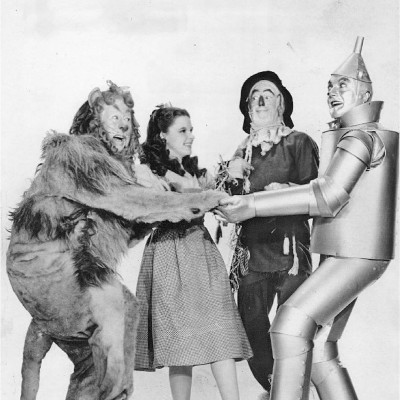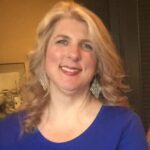 By Michele Rice
By Michele Rice
My sisters and I pulled the large round rug our grandma had crocheted for us as close to the TV as we could get away with. It was winter and cold in our family room, but we didn’t notice as we huddled together, fidgeting with excitement waiting for the commercials to end and our movie to start. Yes, this was before there were VCRs, Netflix, and other viewing options, and we were forced to watch commercials. This was also years before a slip and fall would lead to the end of my teaching career and send me on a journey to find a way to live a happy life, despite having severe chronic pain.
Back to that cold night in January or February. This was the one night of the year that my sisters and I were allowed to stay up late to watch TV, and we were bubbling over with anticipation. Finally, the black and white beginning of the movie started, a hush fell over the room, and for the next few hours, we were filled with awe and wonder as our TV screen changed from black and white to brilliant colors. We screeched with fear when the wicked witch and flying monkeys appeared. We were watching the annual airing of “The Wizard of Oz.”
Flash forward to a chilly morning last month, when I’m checking email on my phone while simultaneously watching the Rose Parade recorded from New Year’s Day. It was nice to have the option to NOT watch commercials. The theme of this year’s parade is “The Power of Hope.” That theme really resonated with me, but more on that later.
I look up and see Kaiser Permanente’s beautiful float filled with the beloved characters of “The Wizard of Oz,” and just like when I was a child, I was entranced. What is it about this story and these characters that continue to captivate me, even as an adult?
The float passes off camera, and I go back to checking my email, one of which is from U.S. Pain Foundation asking if I’d be interested in writing an article for their blog, Remedy. Of course, I said yes, but then I immediately began to worry about what I’d write. I shouldn’t have worried as sometimes the Universe puts things in front of us, or drops them on our heads when we aren’t paying attention, as was the case with me.
Later that day, I was scanning my recordings in search of something else to watch, and I chose an episode of “Challenge” from the Food Network. Lo and behold, the challenge for this episode was to create amazing works of art out of cake and sugar based on, you guessed it, “The Wizard of Oz!”
OK, Universe, I’m starting to get the message, but it took one more figurative bonk on the head, which came that night when I was watching the movie “Judy,” the story of Judy Garland, the actress that played Dorothy in “The Wizard of Oz.” Message received, but how does “The Wizard of Oz” relate to my life with chronic pain?
One of the worst parts of living with debilitating chronic pain is the feeling of fear and hopelessness that often swirls violently through us like a tornado. What if this pain never goes away? What if it spreads? What if I can’t walk again? What if I can’t go back to work? What if the doctors can’t help me? What if, God forbid, this pain gets worse? Despite these overwhelming fears, I found the strength to keep going, just like Dorothy when she wakes up in Oz and battles her fears of never making it home again. How did Dorothy do it? How did I do it?
I go back to the theme of this year’s Rose Parade, “The Power of Hope.” In the movie, “The Wizard of Oz,” the ruby slippers represent the little guy’s ability to triumph over powerful forces. Dorothy is determined to get to Oz as she believes the Wizard is the only one that has the power to get her back home to Kansas and her family. Wearing the ruby slippers, she sets off down the yellow brick road to Oz, and she encounters many obstacles that could have made her give up hope. The Wicked Witch of the West, flying monkeys, and a field of poppies that put her to sleep.
There have been plenty of times, especially in the earlier years after my diagnosis, where I felt hopeless and sad, but something inside of me refused to give up. In my mind, if I followed the proverbial yellow brick road, it was going to lead me to a doctor that had the magic pill or treatment for my pain. Within the first five years, I had been to at least seven different doctors and at least that many physical therapists. I had tried dozens of medications, endured injection after injection, had frequent visits to the ER, and suffered through several experimental procedures, all in the hopes of finding that elusive end to my pain.
After encountering my versions of wicked witches and flying monkeys, I began to lose hope. Things got so bad that, at one point, I had a bunch of opioids in my mouth, ready to end the pain forever. But even in that darkest moment, I had a glimmer of hope that things could and would get better.
When Dorothy finally makes it to Oz, she discovers that the wizard is nothing more than an ordinary man and that he doesn’t have the power to get her home. She begins to lose hope of ever seeing her family again when Glinda, the good witch, appears and says, “You’ve always had the power to go back to Kansas.” When the scarecrow asks why she didn’t tell her before, Glinda responds, “She wouldn’t have believed me. She had to learn it for herself.”
My story would not have had a happy ending if I hadn’t put down the pill bottle and reached down with both hands to put on those ruby slippers. Rather than give up, I dug deep, clung to that glimmer of hope, and entered an intensive eight-week functional restoration program (FRP).
I completed that program back in 2005, and there have been many fabulous changes to my life since then. I got out of the wheelchair and learned to walk again. I moved out of my parents’ home and live independently. I drive an adapted car, and I’ve become an advocate and teacher for others living with chronic pain. Notice that I did NOT say that I’m cured or that I no longer have pain.
I still live with severe, and oftentimes very debilitating, chronic pain. The difference is that I now have the tools to live a happy life, despite that pain. It is most definitely not an easy journey, and there are plenty of times that I feel that fear and sadness begin to creep into my consciousness again. Thankfully, with the tools that I learned in the FRP, the love and support of my family, a caring pain management team, and most importantly, my refusal to give up hope, I always find a way out of that dark place.
Until recently, I gave almost all of the credit to the staff and doctors at the pain and wellness center for saving my life. Glinda, the good witch, otherwise known as my mom, has told me for years that it wasn’t the clinic that saved my life, but it was me. I didn’t believe her. I guess like Glinda said to Dorothy: I had to learn it for myself.
I suppose I looked at the pain and wellness clinic as my sort of Oz, where magic happens (and don’t get me wrong, wonderful things do happen there every day). But the difference is that I now realize it’s not just because of the team that works there. It’s us, the people living with pain, who have the magic–the magic of hope and the refusal to give up. That’s how Dorothy made it to Oz and eventually back to her family in Kansas, and that’s how I have not just survived a life with chronic pain, but live a happy life despite that pain.
I truly feel that the FRP helped me to discover that doctors aren’t wizards, there’s no such thing as a magic pill or treatment, and that only we have the power to heal our mind, body, and spirit. We have to hold onto our inner scarecrow, tin man, and lion, and when times get dark and the pain gets overwhelming, put on those ruby slippers. Remember that there is always hope for things to get better and that we will triumph over the powerful forces of severe chronic pain by living a good life anyway. It may not be the life we had planned, but it can still be a happy one.
 Michele Rice is a member of the U.S. Pain Foundation staff and an advocate for those living with chronic pain. She is trained as a Pain Connection support group leader and helps run an online support group for those living with RSD/CRPS. She is also a regular speaker on the graduate panel at IPM Medical Group in Los Gatos, CA. Before she began her pain journey, she was a fourth grade school teacher and a pharmacy technician.
Michele Rice is a member of the U.S. Pain Foundation staff and an advocate for those living with chronic pain. She is trained as a Pain Connection support group leader and helps run an online support group for those living with RSD/CRPS. She is also a regular speaker on the graduate panel at IPM Medical Group in Los Gatos, CA. Before she began her pain journey, she was a fourth grade school teacher and a pharmacy technician.
